FDStackView —— Downward Compatible UIStackView (Part 3)
上一篇 Part 2 只介绍了第一个技术点 alignment 和 distribution 的约束如何添加和管理 的 alignment 这一部分的内容,这一篇继续介绍 distribution 的约束添加和管理。
同样的在介绍实现之前,我先介绍一下 StackView 的各种 distribution 模式都是什么效果的:
- UIStackViewDistributionFill :这种应该是目前最常用的了,它就是将
arrangedSubviews填充满整个StackView,如果设置了spacing,那么这些arrangedSubviews之间的间距就是spacing。如果减去所有的spacing,所有的arrangedSubview的固有尺寸(intrinsicContentSize)不能填满或者超出StackView的尺寸,那就会按照Hugging或者CompressionResistance的优先级来拉伸或压缩一些arrangedSubview。如果出现优先级相同的情况,就按排列顺序来拉伸或压缩。
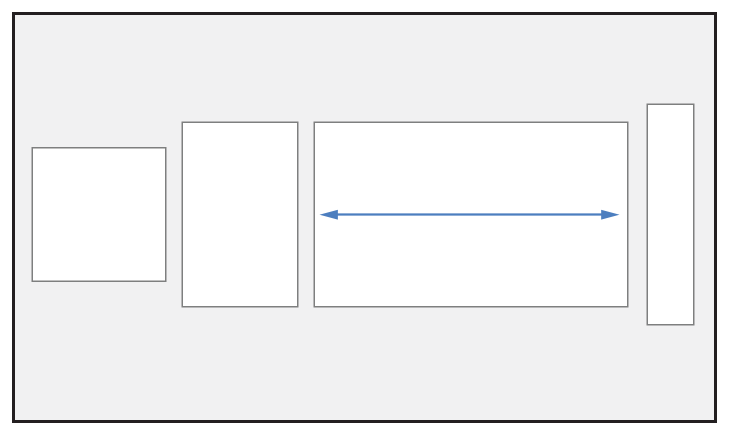
- UIStackViewDistributionFillEqually :这种就是
StackView的尺寸减去所有的spacing之后均分给arrangedSubviews,每个arrangedSubview的尺寸是相同的。
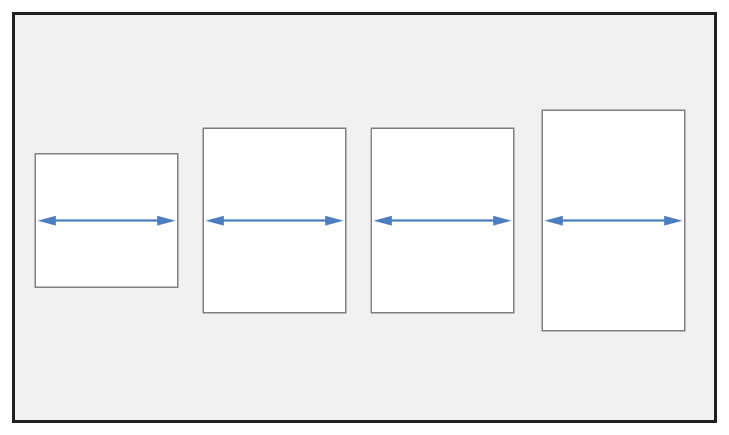
- UIStackViewDistributionFillProportionally :这种跟FillEqually差不多,只不过这个不是讲尺寸均分给
arrangedSubviews,而是根据arrangedSubviews的intrinsicContentSize按比例分配。
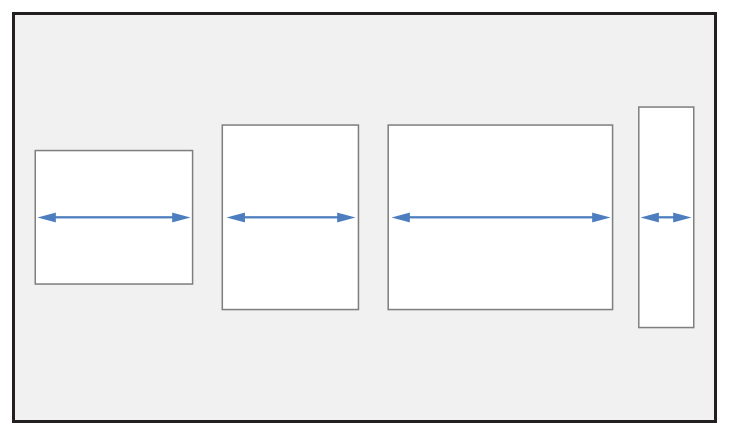
- UIStackViewDistributionEqualSpacing :这种是使
arrangedSubview之间的spacing相等,但是这个spacing是有可能大于StackView所设置的spacing,但是绝对不会小于。这个类型的布局可以这样理解,先按所有的arrangedSubview的intrinsicContentSize布局,然后余下的空间均分为spacing,如果大约StackView设置的spacing那这样就OK了,如果小于就按照StackView设置的spacing,然后按照CompressionResistance的优先级来压缩一个arrangedSubview。
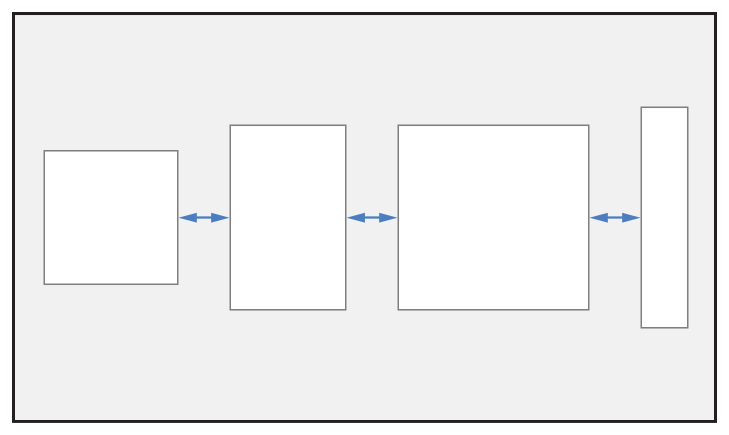
- UIStackViewDistributionEqualCentering :这种是使
arrangedSubview的中心点之间的距离相等,这样没两个arrangedSubview之间的spacing就有可能不是相等的,但是这个spacing仍然是大于等于StackView设置的spacing的,不会是小于。这个类型布局仍然是如果StackView有多余的空间会均分给arrangedSubviews之间的spacing,如果空间不够那就按照CompressionResistance的优先级压缩arrangedSubview。

在介绍 distribution 的约束创建和管理的过程中也涉及到了第二个知识点 spacing 和 distribution 的关系及约束的创建 的内容,所以这两部都在这里介绍了。
distribution 方向同样也包括4种约束,这4种约束也都是添加到 canvas 上的,除此之外它还包括一组通过 NSMapTable 维护的 FDGapLayoutGuide 。
@interface FDStackViewDistributionLayoutArrangement : FDStackViewLayoutArrangement @property (nonatomic, strong) NSMutableArray<NSLayoutConstraint *> *canvasConnectionConstraints; @property (nonatomic, strong) NSMapTable<UIView *, NSLayoutConstraint *> *edgeToEdgeConstraints; @property (nonatomic, strong) NSMapTable<UIView *, NSLayoutConstraint *> *relatedDimensionConstraints; @property (nonatomic, strong) NSMapTable<UIView *, NSLayoutConstraint *> *hiddingDimensionConstraints; @property (nonatomic, strong) NSMapTable<UIView *, FDGapLayoutGuide *> *spacingOrCenteringGuides; @end - canvasConnectionConstraints :它管路的是
arrangedSubviews与canvas之间的约束; - edgeToEdgeConstraints :它管理的是
arrangedSubviews之间一个接一个的约束,这里需要注意这些约束的常量是StackView的spacing,但是关系却不一定是相等。还有就是如果有个arrangedSubview被hidden了那么它仍然参与到edgeToEdge的约束创建及布局中,只不过是把它与后一个arrangedSubview之间的edgeToEdgeConstraint的常量由spacing设置为0。 - relatedDimensionConstraints :它管理的是
arrangedSubviews之间distribution各种相等关系的约束,这里面的管理的约束是StackView的distribution布局的精髓所在。如果是UIStackViewDistributionFill模式的话,是没有relatedDimensionConstraint的。UIStackViewDistributionFillEqually与UIStackViewDistributionFillProportionally使用的是一种类型的约束,而UIStackViewDistributionEqualCentering与UIStackViewDistributionEqualSpacing使用的却是另一种类型的约束,后面在详细介绍。 - hiddingDimensionConstraints :它管理的是当
arrangedSubviews有hidden的时候,该arrangedSubview的有关dimensionAttribute的约束; - spacingOrCenteringGuides :这个管理的就不是约束了,它是一组
FDGapLayoutGuide,只用在UIStackViewDistributionEqualCentering和UIStackViewDistributionEqualSpacing这两种模式中,FDGapLayoutGuide用来连接左右两个arrangedSubView,作为一个辅助view来约束左右两个view的位置关系。spacingOrCenteringGuides的key是FDGapLayoutGuide连接的左边的arrangedSubview。
最后说明的就是 FDGapLayoutGuide 与 arrangedSubView 相连接的约束没有被 NSMapTable 所管理,它们就只是被加到了 canvas 上。因为当模式改变时,所有的 FDGapLayoutGuide 会被移除或者重建,所以跟它们相关的约束也会被一并清楚。
那么以上几种约束的创建顺序是怎样的呢?
- 首先是
canvasConnectionConstraints; - 其次是每一种模式都会涉及到的
edgeToEdgeConstraints; - 然后再遍历所有
arrangedSubviews,如果有arrangedSubview被hidden了,那么就会创建hiddingDimensionConstraints; - 最后是
relatedDimensionConstraints,这里如果是UIStackViewDistributionEqualCentering和UIStackViewDistributionEqualSpacing这两种模式的话,会先创建出spacingOrCenteringGuides。
下面具体来看,首先 canvasConnectionConstraints :
- (void)resetCanvasConnectionsEffect { [self.canvas removeConstraints:self.canvasConnectionConstraints]; if (!self.items.count) return; NSMutableArray *canvasConnectionConstraints = [NSMutableArray new]; NSLayoutAttribute minAttribute = [self minAttributeForCanvasConnections]; NSLayoutConstraint *head = [NSLayoutConstraint constraintWithItem:self.canvas attribute:minAttribute relatedBy:NSLayoutRelationEqual toItem:self.items.firstObject attribute:minAttribute multiplier:1 constant:0]; [canvasConnectionConstraints addObject:head]; head.identifier = @"FDSV-canvas-connection"; NSLayoutConstraint *end = [NSLayoutConstraint constraintWithItem:self.canvas attribute:minAttribute + 1 relatedBy:NSLayoutRelationEqual toItem:self.items.lastObject attribute:minAttribute + 1 multiplier:1 constant:0]; [canvasConnectionConstraints addObject:end]; end.identifier = @"FDSV-canvas-connection"; self.canvasConnectionConstraints = canvasConnectionConstraints; [self.canvas addConstraints:canvasConnectionConstraints]; } 比较简单,先判断一下不需要创建的情况,然后就是根据 axis 选用不同的 NSLayoutAttribute ,将第一个和最后一个 arrangedSubview 分别与 StackView 创建相等的约束。这样一来再加上 FDStackViewAlignmentLayoutArrangement 中创建的两个 canvasConnectionConstraints ,整个 canvas 的上下左右四个方向的约束就都有了,满足了 canvas 布局的基本条件。
接下来是 edgeToEdgeConstraints :
- (void)resetFillEffect { // spacing - edge to edge [self.canvas removeConstraints:self.edgeToEdgeConstraints.fd_allObjects]; [self.edgeToEdgeConstraints removeAllObjects]; [self.canvas removeConstraints:self.hiddingDimensionConstraints.fd_allObjects]; [self.hiddingDimensionConstraints removeAllObjects]; UIView *offset = self.items.car; UIView *last = self.items.lastObject; for (UIView *view in self.items.cdr) { NSLayoutAttribute attribute = [self minAttributeForGapConstraint]; NSLayoutRelation relation = [self edgeToEdgeRelation]; NSLayoutConstraint *spacing = [NSLayoutConstraint constraintWithItem:view attribute:attribute relatedBy:relation toItem:offset attribute:attribute + 1 multiplier:1 constant:self.spacing]; spacing.identifier = @"FDSV-spacing"; [self.canvas addConstraint:spacing]; [self.edgeToEdgeConstraints setObject:spacing forKey:offset]; if (offset.hidden || (view == last && view.hidden)) { spacing.constant = 0; } offset = view; } // hidding dimensions for (UIView *view in self.items) { if (view.hidden) { NSLayoutAttribute dimensionAttribute = [self dimensionAttributeForCurrentAxis]; NSLayoutConstraint *dimensionConstraint = [NSLayoutConstraint constraintWithItem:view attribute:dimensionAttribute relatedBy:NSLayoutRelationEqual toItem:nil attribute:NSLayoutAttributeNotAnAttribute multiplier:1 constant:0]; dimensionConstraint.identifier = @"FDSV-hiding"; [self.canvas addConstraint:dimensionConstraint]; [self.hiddingDimensionConstraints setObject:dimensionConstraint forKey:view]; } } } 先移去旧的相关约束,然后将 arrangedSubviews 依次迭代遍历,根据 axis 选择正确的 NSLayoutAttribute 创建首尾相接的约束,常量为 StackView 的spacing,关系则根据 distribution 的不同而或等于或大于等于。
这里如前面介绍的一样,如果这个 arrangedSubview 是 hidden 的那么它仍然参与 edgeToEdgeConstraints 的创建,只不过它与后一个 arrangedSubview 的约束常量不再是spacing而是 0 。还有一个特殊的就是如果是最后一个 arrangedSubview 被 hidden 了,那么它与前一个 arrangedSubview 的约束的常量也同样是 0 。
最后再遍历所有 arrangedSubviews ,如果有 arrangedSubview 被 hidden 了,那就根据 axis 给这个 arrangedSubview 创建一个常量为 0 的 dimensionConstraint 。
如果是 UIStackViewDistributionFill 的话,那么到这里所有 distribution 的约束就已经创建完了,已经满足需求了。但是其他几种还要有后续的步骤。
先来看 UIStackViewDistributionFillEqually 和 UIStackViewDistributionFillProportionally 这两种类型:
- (void)resetEquallyEffect { [self.canvas removeConstraints:self.relatedDimensionConstraints.fd_allObjects]; [self.relatedDimensionConstraints removeAllObjects]; NSArray<UIView *> *visiableViews = self.visiableItems; UIView *offset = visiableViews.car; CGFloat order = 0; for (UIView *view in visiableViews.cdr) { NSLayoutAttribute attribute = [self dimensionAttributeForCurrentAxis]; NSLayoutRelation relation = NSLayoutRelationEqual; CGFloat multiplier = self.distribution == UIStackViewDistributionFillEqually ? 1 : ({ CGSize size1 = offset.intrinsicContentSize; CGSize size2 = view.intrinsicContentSize; CGFloat multiplier = 1; if (attribute == NSLayoutAttributeWidth) { multiplier = size1.width / size2.width; } else { multiplier = size1.height / size2.height; } multiplier; }); NSLayoutConstraint *equally = [NSLayoutConstraint constraintWithItem:offset attribute:attribute relatedBy:relation toItem:view attribute:attribute multiplier:multiplier constant:0]; equally.priority = UILayoutPriorityRequired - (++order); equally.identifier = self.distribution == UIStackViewDistributionFillEqually ? @"FDSV-fill-equally" : @"FDSV-fill-proportionally"; [self.canvas addConstraint:equally]; [self.relatedDimensionConstraints setObject:equally forKey:offset]; offset = view; } } 仍然是先干掉旧的约束,然后跟前面不同的是要取出所有的 非hidden 的 arrangedSubview 添加约束,而不是所有 arrangedSubview 。
这两个 distribution 类型是将当前 axis 所对应的 dimensionAttribute 的约束作用在 arrangedSubviews 上,如果是 UIStackViewDistributionFillEqually ,那么约束的比例( multiplier )就是 1 ,如果是 UIStackViewDistributionFillProportionally ,那 multiplier 就需要通过计算得出,是通过两个 arrangedSubview 的 intrinsicContentSize 做比值,这样就能保证 arrangedSubview 最终会按照 intrinsicContentSize 的比例来分配 StackView 的空间布局。
再来看 UIStackViewDistributionEqualCentering 和 UIStackViewDistributionEqualSpacing 这两种类型:
- (void)resetSpacingOrCenteringGuides { [self.spacingOrCenteringGuides.fd_allObjects makeObjectsPerformSelector:@selector(removeFromSuperview)]; [self.spacingOrCenteringGuides removeAllObjects]; NSArray<UIView *> *visiableItems = self.visiableItems; if (visiableItems.count <= 1) { return; } [[visiableItems subarrayWithRange:(NSRange){0, visiableItems.count - 1}] enumerateObjectsUsingBlock:^(UIView *item, NSUInteger idx, BOOL *stop) { FDGapLayoutGuide *guide = [FDGapLayoutGuide new]; [self.canvas addSubview:guide]; guide.translatesAutoresizingMaskIntoConstraints = NO; UIView *relatedToItem = visiableItems[idx+1]; NSLayoutAttribute minGapAttribute = [self minAttributeForGapConstraint]; NSLayoutAttribute minContentAttribute; NSLayoutAttribute maxContentAttribute; if (self.distribution == UIStackViewDistributionEqualCentering) { minContentAttribute = self.axis == UILayoutConstraintAxisHorizontal ? NSLayoutAttributeCenterX : NSLayoutAttributeCenterY; maxContentAttribute = minContentAttribute; } else { minContentAttribute = minGapAttribute; maxContentAttribute = minGapAttribute + 1; } NSLayoutConstraint *beginGap = [NSLayoutConstraint constraintWithItem:guide attribute:minGapAttribute relatedBy:NSLayoutRelationEqual toItem:item attribute:maxContentAttribute multiplier:1 constant:0]; beginGap.identifier = @"FDSV-distributing-edge"; NSLayoutConstraint *endGap = [NSLayoutConstraint constraintWithItem:relatedToItem attribute:minContentAttribute relatedBy:NSLayoutRelationEqual toItem:guide attribute:minGapAttribute + 1 multiplier:1 constant:0]; endGap.identifier = @"FDSV-distributing-edge"; [self.canvas addConstraint:beginGap]; [self.canvas addConstraint:endGap]; [self.spacingOrCenteringGuides setObject:guide forKey:item]; }]; } - (void)resetSpacingOrCenteringGuideRelatedDimensionConstraints { [self.canvas removeConstraints:self.relatedDimensionConstraints.fd_allObjects]; NSArray<UIView *> *visiableItems = self.visiableItems; if (visiableItems.count <= 1) return; FDGapLayoutGuide *firstGapGuide = [self.spacingOrCenteringGuides objectForKey:visiableItems.car]; [self.spacingOrCenteringGuides.fd_allObjects enumerateObjectsUsingBlock:^(UIView *obj, NSUInteger idx, BOOL *stop) { if (firstGapGuide == obj) return; NSLayoutAttribute dimensionAttribute = [self dimensionAttributeForCurrentAxis]; NSLayoutConstraint *related = [NSLayoutConstraint constraintWithItem:firstGapGuide attribute:dimensionAttribute relatedBy:NSLayoutRelationEqual toItem:obj attribute:dimensionAttribute multiplier:1 constant:0]; related.identifier = @"FDSV-fill-equally"; [self.relatedDimensionConstraints setObject:related forKey:obj]; [self.canvas addConstraint:related]; }]; } 先创建 spacingOrCenteringGuides ,开始是干掉旧的 spacingOrCenteringGuides 。这里使用的仍然是 visiableItems 。 FDGapLayoutGuide 用来连接左右相连的两个可见 arrangedSubview 。
这两个 distribution 不同的地方就是 UIStackViewDistributionEqualSpacing 的 FDGapLayoutGuide 连接的是 arrangedSubview 的 minAttribute 和 maxAttribute ,而 UIStackViewDistributionEqualCentering 的 FDGapLayoutGuide 连接的却是 arrangedSubview 的 centerAttribute 。
接下来就是创建 relatedDimensionConstraints ,就是根据 axis 不同给对应的 dimensionAttribute 创建相等的约束即可,这些约束是作用在 FDGapLayoutGuide 上的,而与前面那两种 distribution 类型不同。这就是一开始说的 relatedDimensionConstraints 中的两种类型的约束。
到此整个 distribution 方向的约束也都创建完了。加上 alignment 方向创建的约束, StackView 已经可以使用了。
介绍完这些再回过头来看 本文章 Part 1 中后面提到的 UIStackView 的第一个bug,当存在spacing的时候 UIStackViewDistributionFillProportionally 这个类型的 StackView 是烂掉的。我刚才看了一下,苹果仍然没有修复这个bug。
具体的原因那篇文章中已经解释了,现在说下为什么 FDStackView 没有这个问题,相信看完前面创建约束的过程,读者朋友应该就能发现我们并没有像 UIStackView 那样将 canvas 的 dimensionAttribute 乘以一个系数作为 arrangedSubview 的 dimensionConstraint 。我们的 arrangedSubview 的 dimensionConstraint 是与 canvas 无关的,是 arrangedSubviews 之间的比例关系,而且spacing在之前的 edgeToEdgeConstraints 中就已经创建了,这两者是分开创建的,所以算法不同,自然也就不会出现这个bug。
下面看其余的知识点:
子视图的隐藏显示如何处理
如果一个已经布好局的 StackView ,在一个 arrangedSubview 被 hidden 或者 show 之后,那么其余的 arrangedSubviews 也要做出相应变化,来相应这种变化。
在 FDStackView 这里我们是通过 KVO 监测每一个 arrangedSubview 的 hidden 属性,当任何一个 arrangedSubview 属性发生变化后,我们就通过 rebuild 的方式重新创建整个 StackView 的约束,就是重新布局一遍。这是目前 1.0 版本的处理方式,这样势必会带来性能的损失,这也是我们后续优化性能的关键。
子视图的 intrinsicContentSize 发生变化时如何处理
什么叫子视图的 intrinsicContentSize 发生变化呢?举个例子,一个已经布好局的 StackView ,其中有一个 arrangedSubview 是一个 UILabel ,但是这个 UILabel 被重新 setText 了,那么它的 intrinsicContentSize 就会发生变化,自然 StackView 的布局如果不发生变化的话就是错误的。所以在这种情况下 StackView 也要做出处理。
这里我们研究了 UIStackView 的实现方式,一个 arrangedSubview 的 intrinsicContentSize 发生变化如何被捕捉到,是我们未知的, UIKit 并没有暴露任何方法给我们,我们只能通过下符号断点的方式给dump出来的 UIStackView 的私有类。
研究发现当一个 arrangedSubview 的 intrinsicContentSize 发生变化时, UIStackView 总会调用到 _intrinsicContentSizeInvalidatedForChildView: 这个私有方法,参数为发生变化的 arrangedSubview 。所以我们就把这一私有方法给替换了,借助 UIKit 内部的机制来帮我们通知一个 arrangedSubview 的 intrinsicContentSize 发生变化的这种情况。
// Use non-public API in UIView directly is dangerous, so we inject at runtime. + (void)load { static dispatch_once_t onceToken; dispatch_once(&onceToken, ^{ SEL selector = NSSelectorFromString(@"_intrinsicContentSizeInvalidatedForChildView:"); Method method = class_getInstanceMethod(self, @selector(intrinsicContentSizeInvalidatedForChildView:)); class_addMethod(self, selector, method_getImplementation(method), method_getTypeEncoding(method)); }); } 接到这种通知之后,我们目前也是通过 rebuild 的方式来重建 StackView 的约束的。其实对于这种情况以及上面提到的 hidden 的情况,我们都能得到具体发生变化的那个 arrangedSubview ,这也将会是后续优化的突破口。
到此整个 FDStackView 的设计实现过程都介绍完了,当然还有一些零零碎碎的点没有说,都在源码里了。后续版本会增加 Layout Margins 的支持,以及性能优化。
最后在附一张 UIStackView 及 FDStackView 在不同 iOS 系统上加载运行图:
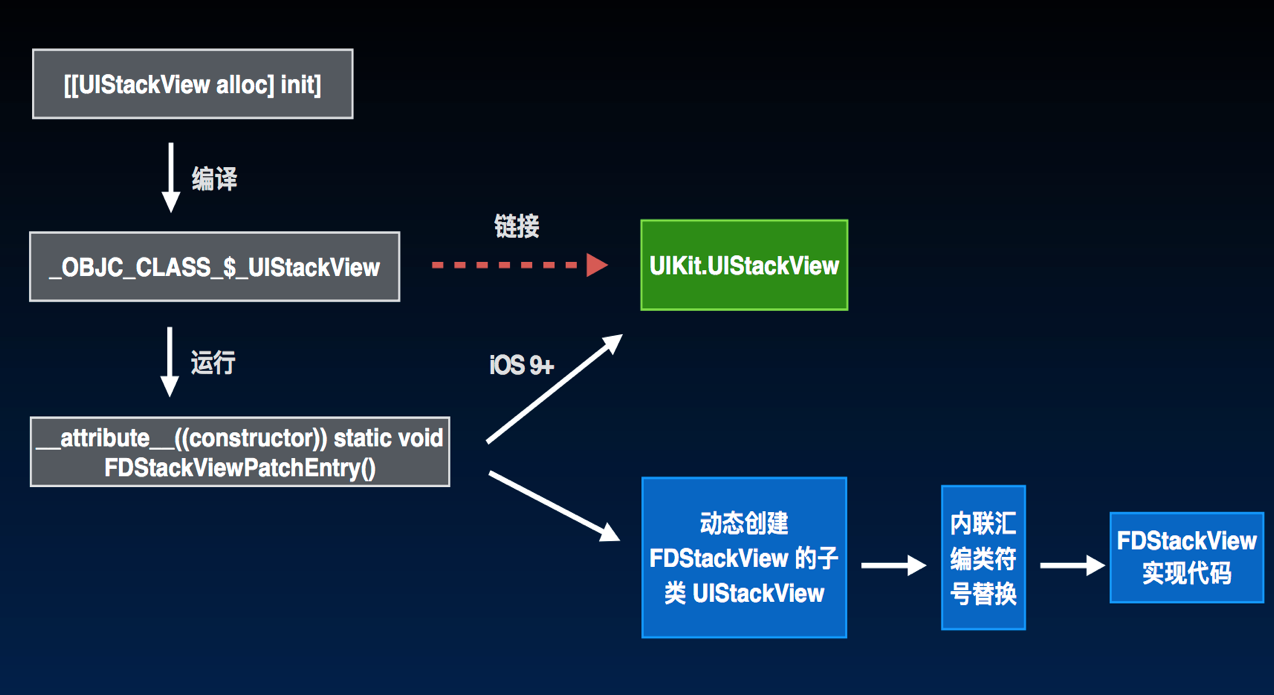
全文完,转载请注明出处,谢谢阅读。











![[HBLOG]公众号](https://www.liuhaihua.cn/img/qrcode_gzh.jpg)

